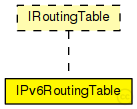 This documentation is released under the Creative Commons license
This documentation is released under the Creative Commons licenseIPv6 Routing Table and Neighbour Discovery data structures. NOTE: This component MUST be named as "routingTable6" inside a StandardHost/Router etc. in order to be accessible by the IPv6 and other modules
See also: IPv6, IPv6NeighbourDiscovery, ICMPv6

The following diagram shows usage relationships between types. Unresolved types are missing from the diagram.

The following diagram shows inheritance relationships for this type. Unresolved types are missing from the diagram.

| Name | Type | Default value | Description |
|---|---|---|---|
| interfaceTableModule | string |
The path to the InterfaceTable module |
|
| ipv6TunnelingModule | string | "^.networkLayer.iptunneling" | |
| routes | xml | xml(" |
|
| forwarding | bool | false | |
| isRouter | bool | this.forwarding | |
| multicastForwarding | bool | false | |
| useAdminDist | bool | false |
Use Cisco like administrative distances |
| Name | Value | Description |
|---|---|---|
| display | i=block/table |
| Name | Type | Unit |
|---|---|---|
| NF_ROUTE_DELETED | IPv6Route | |
| NF_MROUTE_ADDED | IPv6MulticastRoute | |
| NF_MROUTE_CHANGED | IPv6MulticastRoute | |
| NF_ROUTE_ADDED | IPv6Route | |
| NF_MROUTE_DELETED | IPv6MulticastRoute | |
| NF_ROUTE_CHANGED | IPv6Route |
// // IPv6 Routing Table and Neighbour Discovery data structures. // NOTE: This component MUST be named as "routingTable6" inside // a StandardHost/Router etc. in order to be accessible by the // ~IPv6 and other modules // // @see ~IPv6, ~IPv6NeighbourDiscovery, ~ICMPv6 // simple IPv6RoutingTable like IRoutingTable { parameters: string interfaceTableModule; // The path to the InterfaceTable module string ipv6TunnelingModule = default("^.networkLayer.iptunneling"); @display("i=block/table"); xml routes = default(xml("<routingTable/>")); bool forwarding = default(false); bool isRouter = default(this.forwarding); bool multicastForwarding = default(false); bool useAdminDist = default(false); // Use Cisco like administrative distances @signal[NF_ROUTE_ADDED](type=IPv6Route); @signal[NF_ROUTE_CHANGED](type=IPv6Route); @signal[NF_ROUTE_DELETED](type=IPv6Route); @signal[NF_MROUTE_ADDED](type=IPv6MulticastRoute); @signal[NF_MROUTE_DELETED](type=IPv6MulticastRoute); @signal[NF_MROUTE_CHANGED](type=IPv6MulticastRoute); }